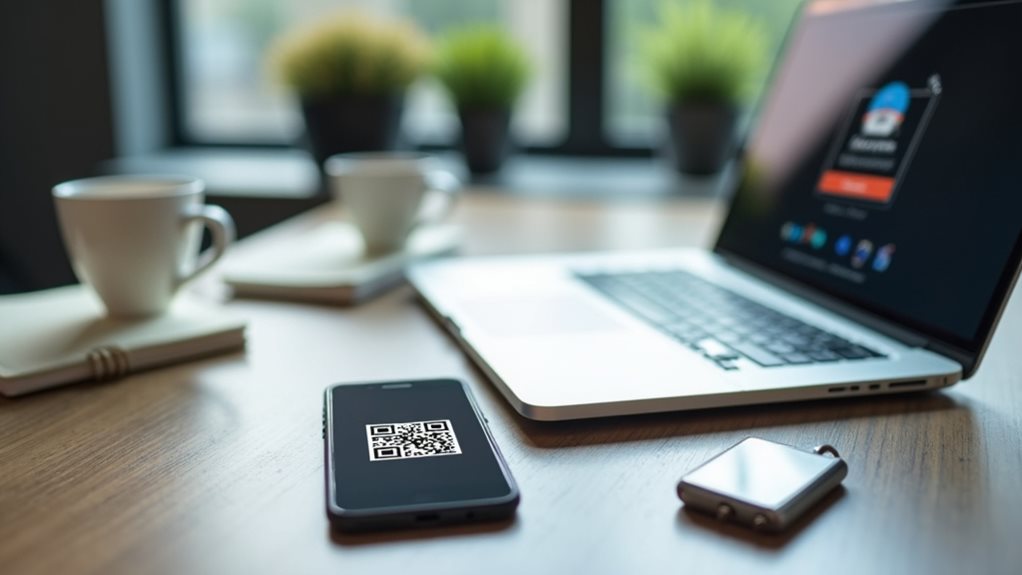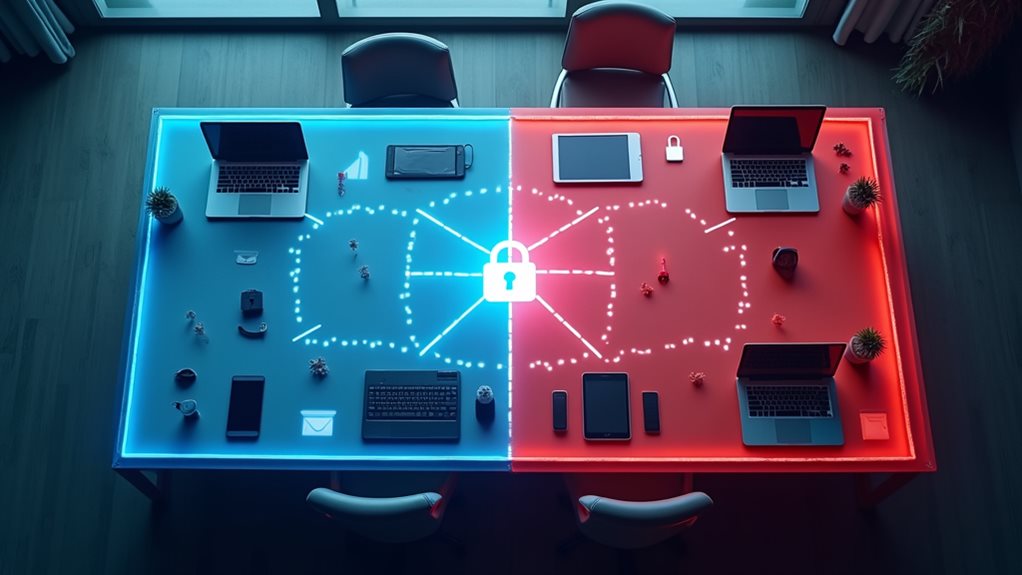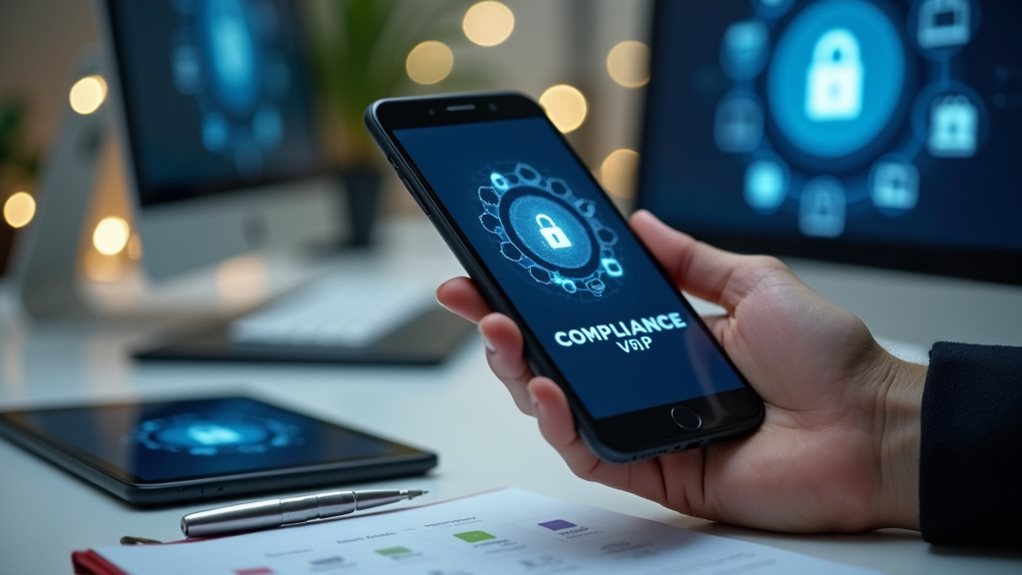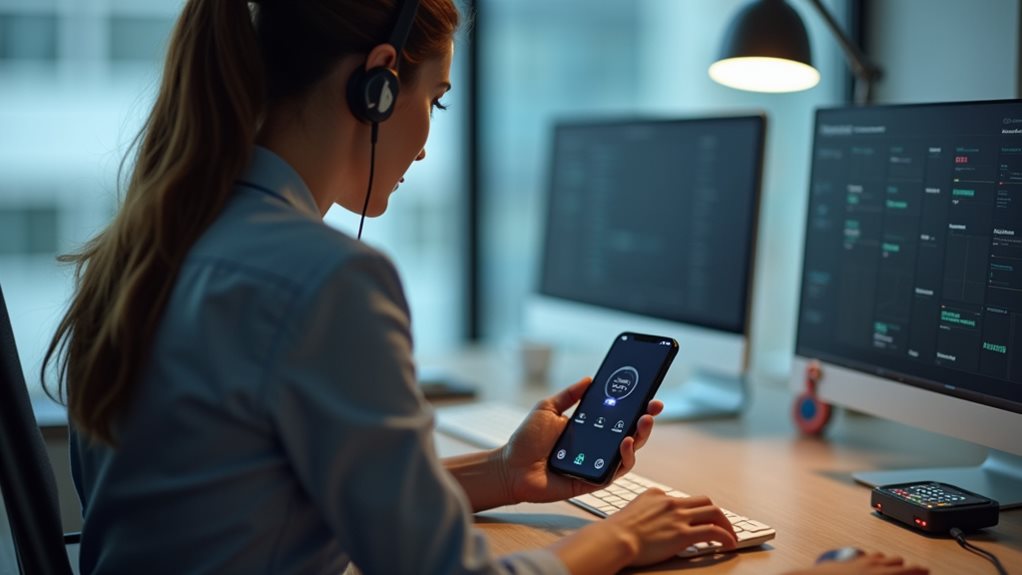To secure BYOD and VoIP integration, you’ll need layered protection measures. Implement strong device registration, multi-factor authentication, and end-to-end encryption for all communications. Create network segmentation to isolate personal devices from sensitive systems, and deploy MDM solutions with containerization technology. Don’t forget regular employee training on security protocols and best practices. With these strategic safeguards in place, you’ll markedly reduce your vulnerability to breaches while maintaining productivity benefits.
Understanding the Security Landscape of BYOD and VoIP Integration
As organizations increasingly adopt both BYOD policies and VoIP technologies, understanding the complex security environment where these two domains intersect becomes crucial for maintaining robust cybersecurity postures.
When you implement BYOD policies without proper security measures, you’re fundamentally opening multiple doors into your network. Your employees’ personal devices often lack enterprise-grade protection, creating vulnerabilities when they connect to your VoIP systems.
To mitigate these risks, you’ll need to implement strong VoIP encryption protocols, guaranteeing that voice data remains protected regardless of the device accessing it. Remember that unsecured mobile endpoints can compromise even the most secure VoIP infrastructure. To enhance security further, consider implementing strong user authentication to ensure that only authorized devices can connect to your VoIP services.
Robust encryption forms your first line of defense against the vulnerabilities that BYOD introduces to VoIP ecosystems.
The challenge isn’t just about securing your network—it’s about securing every potential access point while maintaining the flexibility that makes BYOD attractive.
The Real Business Risks of Unsecured Mobile VoIP Communications
While many organizations focus on the convenience of mobile VoIP solutions, they often overlook the considerable business risks that come with inadequate security measures. When your employees use unsecured VoIP applications on personal devices, you’re fundamentally creating multiple entry points for attackers. VoIP vulnerabilities like call hijacking and eavesdropping can expose sensitive conversations with clients or internal strategy discussions.
Mobile threats compound these risks markedly. Your staff’s devices face risks from public Wi-Fi networks, malicious apps, and outdated software—all potential vectors for compromising your VoIP communications. Without proper encryption and authentication protocols, you’re gambling with your company’s intellectual property and client data. Furthermore, VoIP security risks underscore the importance of robust measures to prevent potential data breaches and ensure secure communications. Remember that a single breach can trigger regulatory penalties, reputation damage, and loss of customer trust that may take years to rebuild.
Essential Security Policies for Managing Personal Devices

Implementing effective BYOD security begins with clear device registration requirements, which you’ll need to enforce consistently across your organization.
You’ll want to establish strong authentication protocols, including multi-factor authentication and biometric verification, to protect sensitive VoIP communications from unauthorized access.
Creating thorough data separation guidelines helps you maintain boundaries between personal and corporate information, reducing the risk of data leakage while respecting employee privacy. Additionally, incorporating strong security measures enhances the overall protection of sensitive communications and helps uphold trust with clients and partners.
Device Registration Requirements
Successful BYOD implementation hinges on establishing clear device registration requirements that form the foundation of your security framework.
You’ll need to develop streamlined device enrollment processes that capture crucial information while not overwhelming employees. This should include device type, operating system version, and unique identifiers that enable tracking within your network.
Implement robust user access controls during registration to verify employee identity and determine appropriate permission levels based on job functions.
Consider requiring multi-factor authentication at this stage to strengthen security from the outset. This aligns with best practices for selecting VoIP providers that emphasize 2FA security measures to protect sensitive communication.
Your registration protocol should also specify which applications employees must install before accessing company resources, such as mobile device management software, VPN clients, and security tools.
Strong Authentication Protocols
Three pillars form the foundation of robust BYOD security: something you know, something you have, and something you are.
When implementing strong authentication for your VoIP systems, you’ll need to balance security with user experience to guarantee adoption across your organization.
Consider these crucial authentication strategies:
- Implement multi-factor authentication that combines passwords with temporary codes sent to employee devices, creating layered protection against credential theft.
- Utilize biometric verification like fingerprint or facial recognition where appropriate—they’re difficult to replicate and streamline the login process.
- Deploy single sign-on solutions that reduce authentication fatigue while maintaining security through centralized credential management.
Furthermore, integrating VoIP for 2FA can significantly enhance the security of user accounts by providing an extra layer of protection.
Data Separation Guidelines
When employees use their personal devices for work, effective data separation becomes your first line of defense against security breaches. Implement a clear data classification system that categorizes information based on sensitivity levels—confidential, internal, and public. This framework helps your team understand which data requires stricter protection measures on their personal devices.
Develop extensive privacy policies that outline boundaries between work and personal data. You’ll need to specify which apps can access corporate information and establish protocols for wiping company data without affecting personal content.
Consider containerization solutions that create isolated workspaces on employees’ devices, effectively separating business applications from personal use. Additionally, implementing advanced encryption protocols can provide an extra layer of security for sensitive information being accessed on personal devices.
Implementing Multi-Factor Authentication for VoIP Access

Implementing multi-factor authentication for your VoIP systems requires choosing between several deployment options that balance security with user convenience.
You’ll need to decide whether biometric authentication (such as fingerprint or facial recognition) aligns better with your organization’s security posture than physical tokens or authenticator apps.
Whatever method you select, you’re creating a critical defense layer that greatly reduces the risk of unauthorized access to sensitive voice communications from personal devices. Additionally, integrating risk-based authentication can further enhance security by triggering additional verification during suspicious activity.
MFA Deployment Options
Successful VoIP security strategies depend heavily on robust multi-factor authentication deployment customized to your organization’s specific needs.
When implementing MFA for your BYOD VoIP environment, you’ll need to evaluate deployment options that balance security with usability. The MFA benefits include reduced breach risk, while MFA challenges involve user adoption and integration complexity.
Consider these implementation approaches:
- Cloud-based MFA solutions – Offer scalability and reduced infrastructure costs while supporting remote workers across multiple devices.
- On-premises deployment – Provides greater control over authentication data and may better satisfy specific compliance requirements.
- Hybrid implementation – Combines cloud flexibility with on-premises security, allowing you to maintain sensitive authentication elements internally while leveraging cloud services for other components.
Your choice should align with your security posture, budget constraints, and technical capabilities. Additionally, implementing strong passwords and multi-factor authentication significantly mitigates unauthorized access and other potential security threats.
Biometrics vs. Tokens
After selecting your MFA deployment approach, you’ll face a critical decision between biometric authentication and security tokens for your BYOD VoIP environment. Each option presents distinct security implications for your organization’s communication infrastructure.
Biometric advantages include inherent user uniqueness—fingerprints and facial recognition can’t be forgotten or easily shared among employees. However, they’re not infallible; quality sensors matter, as poor implementations can create frustrating false rejections or dangerous false acceptances.
Token vulnerabilities stem primarily from their physical nature. They can be lost, stolen, or shared, compromising your VoIP security framework. However, tokens offer consistency that biometrics sometimes lack, especially in varying environmental conditions where fingerprint readers might struggle with dry skin or facial recognition with poor lighting.
Your choice should align with your specific security requirements, user experience priorities, and compliance needs. Implementing preventive measures like regular updates and strong passwords is also crucial for enhancing your overall VoIP security.
End-to-End Encryption: Making Mobile VoIP Calls Secure
How can you guarantee your business conversations remain private when employees use their personal devices for VoIP calls? End-to-end encryption provides the solution, making sure that sensitive information stays protected from interception.
With proper mobile encryption implementation, you’ll transform personal devices into secure communication channels.
Secure your BYOD VoIP environment with these critical steps:
- Deploy VoIP applications that utilize TLS/SRTP secure protocols for all voice traffic.
- Implement certificate-based authentication to verify both endpoints before establishing encrypted connections.
- Conduct regular security audits to identify and patch potential vulnerabilities in your encryption implementation.
Additionally, leveraging DTLS for encryption can further enhance the security of your VoIP calls.
Don’t settle for basic encryption—insist on solutions that protect data at rest and in transit.
Network Segmentation Strategies for BYOD Environments

When personal devices flood your corporate network, security risks multiply exponentially unless proper boundaries exist between them. Implementing robust network segmentation creates critical safety zones that contain potential threats from compromised personal devices.
Start by deploying network access controls that authenticate devices before granting permissions. You’ll want to establish different trust levels—corporate-owned devices receive broader access while personal devices face stricter limitations.
Network authentication isn’t optional—it’s your first line of defense in a multi-tiered access strategy for today’s hybrid device ecosystem.
Create a dedicated guest network isolation zone where BYOD users connect separately from your core infrastructure.
Consider implementing VLANs that group similar devices together while maintaining separation from sensitive systems. This approach contains breaches when they occur, preventing lateral movement across your network.
Mobile Device Management Solutions for VoIP Security
While implementing robust VoIP security on company-owned devices presents enough challenges, securing voice communications across personal devices requires specialized Mobile Device Management (MDM) solutions.
You’ll need a thorough approach that balances security with user experience for your BYOD environment.
Consider these crucial MDM capabilities for your VoIP security strategy:
- Mobile app security analysis that scans for vulnerabilities in VoIP applications before they’re approved for corporate use
- Device tracking features that allow you to remotely locate, lock, or wipe lost devices containing sensitive communications data
- Containerization technology that creates separate, encrypted spaces for work-related VoIP calls and messages without invading employee privacy
You don’t need to choose between security and flexibility—with the right MDM solution, you can confidently adopt BYOD while protecting your voice communications.
Addressing Regulatory Compliance When Using Personal Devices

Four key regulatory frameworks must be considered when implementing BYOD policies for VoIP communications. HIPAA, GDPR, PCI DSS, and SOX requirements don’t disappear simply because an employee uses their personal device.
You’ll need to establish clear boundaries between personal and work-related data while maintaining appropriate access controls.
When preparing for compliance audits, document how your BYOD strategy addresses each regulatory requirement. You can’t afford to overlook call logging, data retention policies, and encryption standards that apply to your industry.
Consider implementing containerization technology that separates work communications from personal use.
Remember that non-compliance penalties can be severe, often exceeding the cost of proper implementation. Your BYOD policy should explicitly outline employee responsibilities for maintaining regulatory standards on their devices.
Employee Training: The Critical Human Element in BYOD Security
Despite sophisticated security technologies and robust policies, your BYOD security strategy ultimately depends on well-trained employees.
You’ll need to develop thorough training programs that transform security awareness into consistent practice.
When designing your employee training initiative, focus on:
- Regular, bite-sized security updates rather than overwhelming annual sessions to maintain continuous employee engagement
- Scenario-based training that simulates real-world security threats employees might encounter while using personal devices
- Personalized learning paths that address the specific security risks associated with each employee’s role and device usage patterns
Remember that effective security isn’t just about compliance—it’s about building a culture where employees understand why these measures matter and how their actions directly impact your organization’s security posture.
Frequently Asked Questions
How Does BYOD Impact Voip Call Quality and Bandwidth Requirements?
BYOD increases bandwidth demands as personal devices add network strain. You’ll need bandwidth optimization strategies and call prioritization configurations to maintain voice quality when multiple employee devices compete for network resources simultaneously.
Can Legacy Voip Systems Support Modern BYOD Security Features?
Legacy VoIP systems typically can’t support modern BYOD security features due to legacy system limitations. You’ll need to implement gateway solutions or upgrades to add modern security improvements like encryption, device authentication, and access controls.
What Costs Should Businesses Expect When Implementing Secure BYOD Voip?
You’ll face costs for MDM software, security upgrades, training, compliance audits, and infrastructure updates. Don’t forget ongoing expenses. A thorough cost analysis and proper budget considerations will prevent unexpected financial surprises during implementation.
How Do International Roaming Employees Maintain Secure Voip Connections?
You’ll maintain secure VoIP connections internationally by using VPNs, implementing strong encryption standards, following your company’s security policies, and guaranteeing proper device management across borders. Don’t forget to update security settings regularly.
Can Personal Voip Apps Be Integrated With Corporate Communications Systems?
Yes, you can integrate personal VoIP apps with corporate systems through secure gateways that enforce personal app security protocols and corporate compliance requirements. You’ll need proper authentication methods and IT department approval first.
Final Thoughts
You’ve now got the crucial tools to secure your BYOD VoIP implementation. Remember, it’s not merely about technology—it’s about balancing convenience with robust protection. By implementing proper authentication, encryption, and training, you’ll mitigate considerable risks while maintaining flexibility. Don’t wait for a breach to take action; start integrating these security measures today. Your organization’s data integrity and communication privacy depend on your vigilance.

